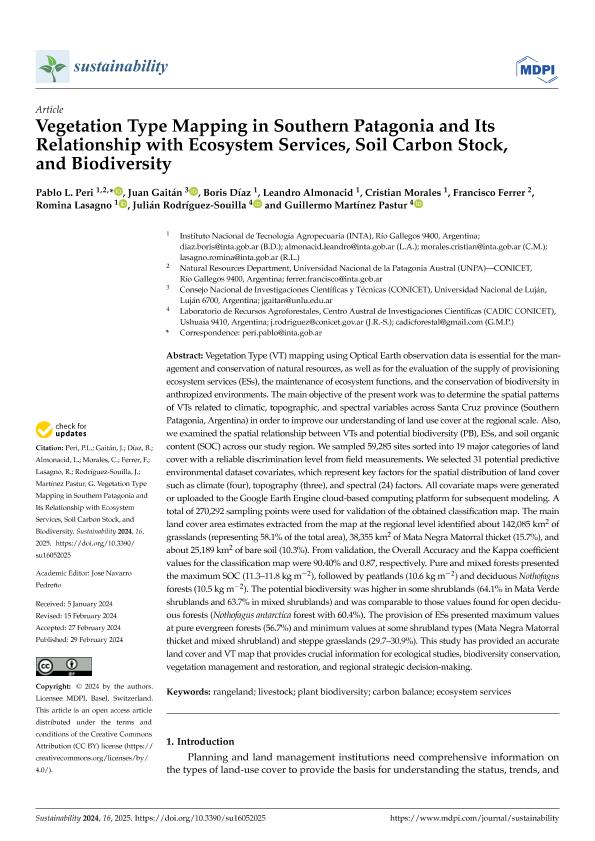Mostrar el registro sencillo del ítem
dc.contributor.author
Peri, Pablo Luis

dc.contributor.author
Gaitán, Juan José

dc.contributor.author
Diaz, Boris Gastón

dc.contributor.author
Almonacid, Leandro
dc.contributor.author
Morales, Cristian
dc.contributor.author
Ferrerer, Francisco
dc.contributor.author
Lasagno, Romina
dc.contributor.author
Rodriguez Souilla, Julian

dc.contributor.author
Martínez Pastur, Guillermo José

dc.date.available
2024-03-15T12:58:37Z
dc.date.issued
2024-02
dc.identifier.citation
Peri, Pablo Luis; Gaitán, Juan José; Diaz, Boris Gastón; Almonacid, Leandro; Morales, Cristian ; et al.; Vegetation Type mapping in Southern Patagonia and its relationship with ecosystem services, soil carbon stock, and biodiversity; MDPI; Sustainability; 16; 2025; 2-2024; 1-15
dc.identifier.issn
2071-1050
dc.identifier.uri
http://hdl.handle.net/11336/230669
dc.description.abstract
Vegetation Type (VT) mapping using Optical Earth observation data is essential for the management and conservation of natural resources, as well as for the evaluation of the supply of provisioning ecosystem services (ESs), the maintenance of ecosystem functions, and the conservation of biodiversity in anthropized environments. The main objective of the present work was to determine the spatial patterns of VTs related to climatic, topographic, and spectral variables across Santa Cruz province (Southern Patagonia, Argentina) in order to improve our understanding of land use cover at the regional scale. Also, we examined the spatial relationship between VTs and potential biodiversity (PB), ESs, and soil organic content (SOC) across our study region. We sampled 59,285 sites sorted into 19 major categories of land cover with a reliable discrimination level from field measurements. We selected 31 potential predictive environmental dataset covariates, which represent key factors for the spatial distribution of land cover such as climate (four), topography (three), and spectral (24) factors. All covariate maps were generated or uploaded to the Google Earth Engine cloud-based computing platform for subsequent modeling. A total of 270,292 sampling points were used for validation of the obtained classification map. The main land cover area estimates extracted from the map at the regional level identified about 142,085 km2 of grasslands (representing 58.1% of the total area), 38,355 km2 of Mata Negra Matorral thicket (15.7%), and about 25,189 km2 of bare soil (10.3%). From validation, the Overall Accuracy and the Kappa coefficient values for the classification map were 90.40% and 0.87, respectively. Pure and mixed forests presented the maximum SOC (11.3–11.8 kg m−2), followed by peatlands (10.6 kg m−2) and deciduous Nothofagus forests (10.5 kg m−2). The potential biodiversity was higher in some shrublands (64.1% in Mata Verde shrublands and 63.7% in mixed shrublands) and was comparable to those values found for open deciduous forests (Nothofagus antarctica forest with 60.4%). The provision of ESs presented maximum values at pure evergreen forests (56.7%) and minimum values at some shrubland types (Mata Negra Matorral thicket and mixed shrubland) and steppe grasslands (29.7–30.9%). This study has provided an accurate land cover and VT map that provides crucial information for ecological studies, biodiversity conservation, vegetation management and restoration, and regional strategic decision-making.
dc.format
application/pdf
dc.language.iso
eng
dc.publisher
MDPI
dc.rights
info:eu-repo/semantics/openAccess
dc.rights.uri
https://creativecommons.org/licenses/by/2.5/ar/
dc.subject
RANGELAND
dc.subject
LIVESTOCK
dc.subject
PLANT BIODIVERSITY
dc.subject
ECOSYSTEM SERVICES
dc.subject.classification
Otras Ciencias Biológicas

dc.subject.classification
Ciencias Biológicas

dc.subject.classification
CIENCIAS NATURALES Y EXACTAS

dc.title
Vegetation Type mapping in Southern Patagonia and its relationship with ecosystem services, soil carbon stock, and biodiversity
dc.type
info:eu-repo/semantics/article
dc.type
info:ar-repo/semantics/artículo
dc.type
info:eu-repo/semantics/publishedVersion
dc.date.updated
2024-03-15T11:36:11Z
dc.journal.volume
16
dc.journal.number
2025
dc.journal.pagination
1-15
dc.journal.pais
Suiza

dc.description.fil
Fil: Peri, Pablo Luis. Consejo Nacional de Investigaciones Científicas y Técnicas. Centro de Investigaciones y Transferencia de Santa Cruz. Universidad Tecnológica Nacional. Facultad Regional Santa Cruz. Centro de Investigaciones y Transferencia de Santa Cruz. Universidad Nacional de la Patagonia Austral. Centro de Investigaciones y Transferencia de Santa Cruz; Argentina
dc.description.fil
Fil: Gaitán, Juan José. Universidad Nacional de Luján; Argentina. Consejo Nacional de Investigaciones Científicas y Técnicas; Argentina
dc.description.fil
Fil: Diaz, Boris Gastón. Instituto Nacional de Tecnología Agropecuaria; Argentina
dc.description.fil
Fil: Almonacid, Leandro. Instituto Nacional de Tecnología Agropecuaria; Argentina
dc.description.fil
Fil: Morales, Cristian. Instituto Nacional de Tecnología Agropecuaria; Argentina
dc.description.fil
Fil: Ferrerer, Francisco. Universidad Nacional de la Patagonia Austral; Argentina
dc.description.fil
Fil: Lasagno, Romina. Instituto Nacional de Tecnología Agropecuaria; Argentina
dc.description.fil
Fil: Rodriguez Souilla, Julian. Consejo Nacional de Investigaciones Científicas y Técnicas. Centro Austral de Investigaciones Científicas; Argentina
dc.description.fil
Fil: Martínez Pastur, Guillermo José. Consejo Nacional de Investigaciones Científicas y Técnicas. Centro Austral de Investigaciones Científicas; Argentina
dc.journal.title
Sustainability
dc.relation.alternativeid
info:eu-repo/semantics/altIdentifier/doi/https://doi.org/10.3390/su16052025
Archivos asociados
